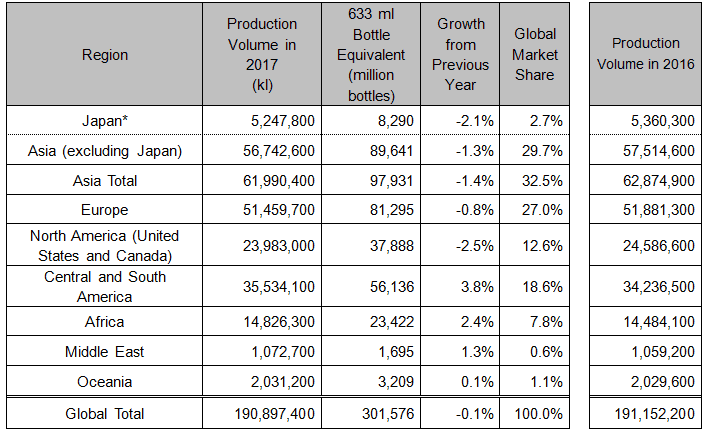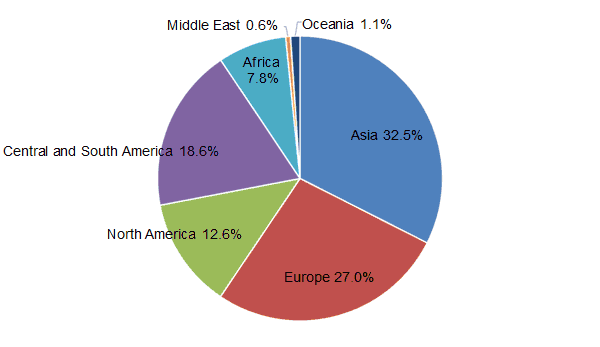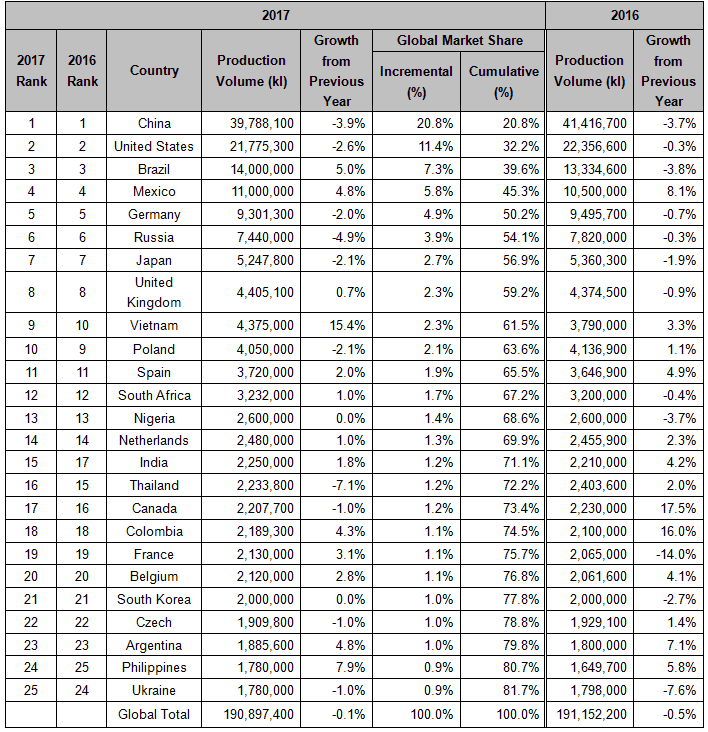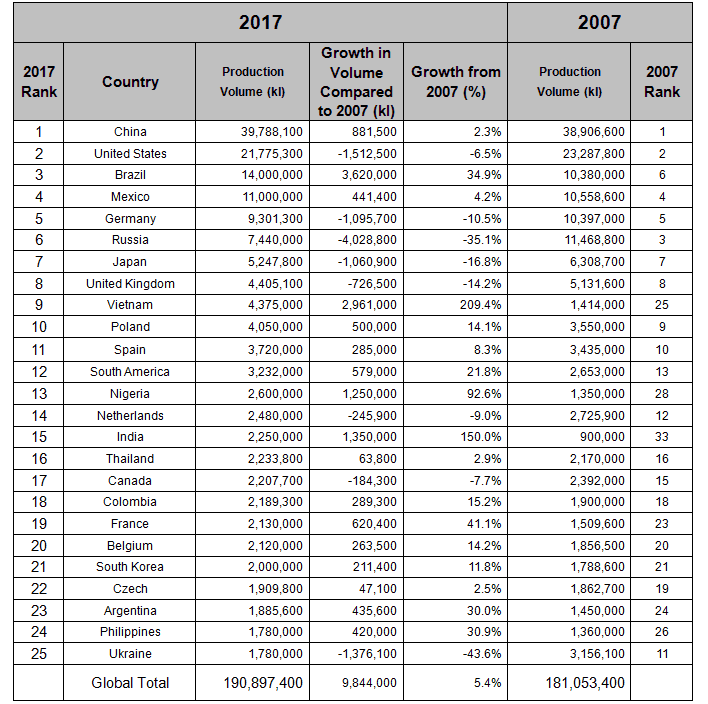Kirin Company, Limited (President and CEO: Yoshinori Isozaki; hereafter “Kirin”) operates the Kirin Beer University (http://www.kirin.co.jp/entertainment/daigaku/), a virtual university on the Internet which was established in July 2001 to promote the enjoyment of beer and deep knowledge about beer to consumers. With various faculties and facilities, consumers can learn about a variety of topics, ranging from the best way to drink delicious beer to other interesting facts about beer — 24 hours a day, 365 days a year.
This report publishes the details of global beer production in 171 major countries and regions for 2017. The report is based on findings obtained from questionnaires sent by Kirin to various brewers’ associations around the world, as well as the latest industry statistics available overseas. The data for global beer production has been tracked by Kirin since 1974.
Main Topics
- Global beer production was approximately 190.90 million kiloliters in 2017, down 0.1% from the previous year for a decrease of four consecutive years*1.
- By region, Asia produced 1.4% less beer in 2017 compared to 2016, but still holds a 32.5% share of the global beer market, remaining the world’s largest beer-producing region for the ninth consecutive year. Central and South America—in third place with a market share of 18.6%—and Africa—in fifth place with a market share of 7.8%—saw an increase of 3.8% and 2.4% respectively from the previous year.
- By country, China remained the largest beer-producing country in the world for the 16th consecutive year, even with a decrease of 3.9% in 2017 compared to the previous year. It is followed by the United States, which saw a decrease of 2.6%, and Brazil, which increased by 5.0%. Japan remained in seventh place, seeing a decrease of 2.1% in 2017 compared to the previous year.
In 2017, global beer production decreased about 0.25 million kiloliters to reach approximately 190.90 million kiloliters. In comparison with 2016, there was an annual decrease of 0.1%. The total volume of the global beer production is equivalent to about 154 Tokyo Domes, if the stadium was a beer mug with a capacity of about 1.24 million kiloliters.
1. Global Beer Production by Region in 2017 (Table 1)
Asia remains the world’s largest beer-producing region for the ninth consecutive year, despite a decrease of 1.4% compared to the previous year. Although annual production increased in Vietnam (+15.4%), India (+1.8%), and Philippines (+7.9%), the decrease in China (-3.9%) led to the overall decrease.
2. Global Beer Production by Country in 2017 (Table 2)
China remained the largest beer-producing country in the world for the 16th consecutive year, despite a decrease of 3.9% compared to 2016.
Japan*2 remained in seventh place, seeing a decrease of 2.1% in 2017 compared to the previous year.
3. Comparison with 2007 (Table 3)
Global beer production in 2017 has increased by approximately 9.84 million kiloliters, a growth of 5.4%, when compared to 10 years ago. In terms of volume, Brazil increased by approximately 3.62 million kiloliters, Vietnam by approximately 2.96 million kiloliters, and India by approximately 1.35 million kiloliters. In terms of proportion, Vietnam grew by 3.1 times, and India by 2.5 times, which is significant growth among the top countries.
Looking at the top 10 countries, Vietnam rose from 25th place to ninth. For countries ranked between the 11th and 25th places, Nigeria rose from 28th to 13th, India rose from 33rd to 15th, and France rose from 23rd to 19th.
The Kirin Group is committed to creating a new beverage culture side by side with our consumers, and fostering well-being and prosperity among people and communities.
Note: Due to rounding, figures may not always add up to the total.
- *1Among the countries whose figures for last year were revised for this year’s report, the revised figures are used for calculations.
The figures for global beer production in 2016 and 2015 have also been revised to the latest figures
2016: Changed from 190.92 million kiloliters to 191.15 million kiloliters
2015: Changed from 191.99 million kiloliters to 192.14 million kiloliters
- *2Production volume in Japan is a combination of beer, happo-shu (low-malt beer), and new genre (non-malt beer).
Source: Questionnaires sent by Kirin to the brewers’ associations in major countries. The Barth Report Hops 2017/2018 (BARTH−HAAS GROUP)
(Table 1) Global Beer Production by Region in 2017
Beer Production by Region, Growth from Previous Year, and Global Market Share

- *Production volume in Japan is a combination of beer, happo-shu (low-malt beer), and new genre (non-malt beer).
- *Due to rounding, the numbers may not actually add up to the total.
Comments
- Although beer production increased in Central and South America, Africa, the Middle East, and Oceania, global beer production decreased for the fourth consecutive year.
- Asia remained at the top for the ninth consecutive year, despite a decrease of 1.4% compared to 2016. Although top-placed China decreased by 3.9%, Asia maintained its rank due to the strong performance of Vietnam, which grew 15.4%, India, which grew 1.8%, and the Philippines, which grew 7.9%.
- Compared to 2016, Central and South America increased by 3.8%, Africa by 2.4%, the Middle East by 1.3%, and Oceania by 0.1%.
2017 Global Market Share of Beer Production by Region

(Table 2) Global Beer Production by Country in 2017

- *Production volume in Japan is a combination of beer, happo-shu (low-malt beer), and new genre (non-malt beer).
- *Due to rounding, the numbers may not actually add up to the total.
Comments
- Global beer production was approximately 190.90 million kiloliters in 2017. Although production in the leading countries—such as Brazil and Mexico—increased, there was a drop of 0.1% compared to 2016 due to lower production volumes in China and the United States, the top two leading countries.
- Total production volume in China dropped by 3.9% compared to 2016 due to the maturing and saturation of consumer demand. Still, products in the mid to high price range have been strong.
- Vietnam saw an economic growth rate of 6.8% in 2017, the highest recorded growth rate since 2008. Beer production increased by 15.4% compared to 2016 likely due to brisk consumer trends accompanying economic growth leading to an increase in beer intake.
- In the Philippines, where beer production increased 7.9% compared to 2016, sectors such as manufacturing, service, and agriculture have been strong. In addition, consumption has increased due to sustained economic expansion, including an improvement in employment. The trend in alcohol consumption is also shifting from the mainstream brandy—which is cheap—toward beer, a high-class product.
- Beer production in Thailand dropped by 7.1% compared to 2016 likely due to the increase in prices arising from the alcohol tax revision in September, and the solemn mood from the demise of the nation’s king and other effects.
(Table 3) Global Beer Production by Country in 2017—Comparison with 2007

- *Production volume in Japan is a combination of beer, happo-shu (low-malt beer), and new genre (non-malt beer).
Comments
- Comparing global beer production in 2017 with that of 10 years ago, there was an increase of approximately 9.84 million kiloliters, a growth rate of 5.4%. Brazil had the largest increase in volume, growing by approximately 3.62 million kiloliters. It is followed by Vietnam (at approximately 2.96 million kiloliters) and India (at approximately 1.35 million kiloliters).